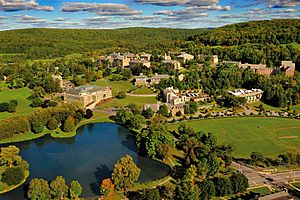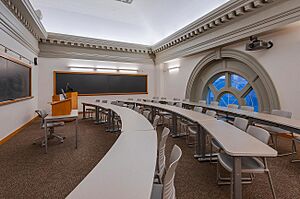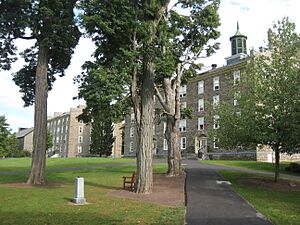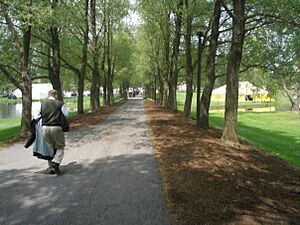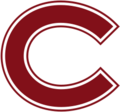Colgate University facts for kids
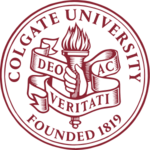 |
|
|
Former names
|
Baptist Education Society of the State of New York (1819–1823) Hamilton Literary & Theological Institution (1823–1846) Madison University (1846–1890) |
|---|---|
| Motto | Deo ac Veritati (Latin) |
|
Motto in English
|
For God and for Truth |
| Type | Private liberal arts college |
| Established | 1819 |
|
Academic affiliations
|
Space-grant |
| Endowment | $1.3 billion (as of December 31, 2024) |
| President | Brian W. Casey |
| Provost | Lesleigh Cushing |
|
Academic staff
|
355 (2018) |
| Undergraduates | 3,219 (2022) |
| Postgraduates | 11 (2018) |
| Location |
,
New York
,
United States
42°49′10″N 75°32′11″W / 42.81944°N 75.53639°W |
| Campus | Rural, 575 acres (233 ha) |
| Colors | Maroon & white |
| Nickname | Raiders |
|
Sporting affiliations
|
NCAA Division I FCS – Patriot League, ECAC Hockey MAISA |
| Mascot | Raider |
Colgate University is a private college located in Hamilton, New York, in the United States. It is a liberal arts college, which means it focuses on a broad education in many subjects. The college was started in 1819. It has had a few different names over the years, including Baptist Education Society of the State of New York, Hamilton Theological and Literary Institution, and Madison College, before becoming Colgate University in 1890.
Colgate has about 3,200 students who are working towards a Bachelor of Arts degree. Students can choose from 56 different main subjects. The college also has a very small program for students who want to earn a Master of Arts in Teaching degree. Students at Colgate can join over 200 different clubs and groups. The college also has sports teams that compete in NCAA Division I, which is the highest level of college sports. They are part of the Patriot League and ECAC Hockey.
Contents
History of Colgate University
In 1817, a group of thirteen men, including six religious leaders, started the Baptist Education Society of the State of New York. Two years later, in 1819, the state officially approved the school. Classes began in 1820 in the town of Hamilton.
In 1823, the school joined with another group and changed its name to the Hamilton Literary & Theological Institution. One of the important people involved was William Colgate, who founded the famous Colgate Company.
In 1826, the school bought land that would become the main part of the campus, known as "The Hill." Students and teachers built West Hall in 1827 using stone from a nearby quarry. West Hall is the oldest building on campus. In 1846, the school became Madison University. Later, in 1890, it changed its name to Colgate University to honor the Colgate family, who had given a lot of money to the school. James Boorman Colgate, William Colgate's son, gave $1 million to the university.
During World War II, Colgate University was one of many colleges that helped train students for the Navy through a program called V-12.
Colgate University has a plan to help students from different financial backgrounds. For students from families earning $80,000 or less, tuition is completely free. For families earning between $80,000 and $150,000, the cost is a small percentage of their income. For all students, Colgate aims to cover 100% of their financial need.
Welcoming Female Students
When Colgate first started, it was only for male students. However, female students began to attend some classes as early as the mid-1800s. Emily Taylor, whose father was the president at the time, was one of the first.
The first female student to attend full-time was Mabel Dart, from 1878 to 1882. At that time, the university arranged for her to receive her degree from an all-female college, Vassar College, so she wouldn't feel out of place graduating from an all-male school.
More female students joined classes over the years, including wives of teachers and veterans. Finally, in 1970, Colgate became fully coeducational, meaning both male and female students could attend all programs.
University Leaders
Colgate University has had many presidents throughout its history. Here is a list of them:
| Number | President | Years served |
|---|---|---|
| 1 | Nathaniel Kendrick | 1836–1848 |
| 2 | Stephen William Taylor | 1851–1856 |
| 3 | George Washington Eaton | 1856–1868 |
| 4 | Ebenezer Dodge | 1868–1890 |
| 5 | George William Smith | 1895–1897 |
| 6 | George Edmands Merrill | 1899–1908 |
| 7 | Elmer Burritt Bryan | 1909–1921 |
| 8 | George Barton Cutten | 1922–1942 |
| 9 | Everett Needham Case | 1942–1962 |
| 10 | Vincent MacDowell Barnett Jr. | 1963–1969 |
| 11 | Thomas Alva Bartlett | 1969–1977 |
| 12 | George D. Langdon Jr. | 1978–1988 |
| 13 | Neil R. Grabois | 1988–1999 |
| 14 | Charles Karelis | 1999–2001 |
| 15 | Rebecca Chopp | 2002–2009 |
| 16 | Jeffrey Herbst | 2010–2015 |
| 17 | Brian Casey | 2016–present |
A Past President's Views
Colgate's eighth president, George Barton Cutten, made some statements that are now seen as unfair and not welcoming to immigrants. For example, he once said that immigration could harm the "higher divisions of the white race."
Even though President Cutten helped develop Colgate's reputation and buildings, his views on race are not supported by the university today. In 2006, students protested against buildings named after him. In 2017, Colgate removed Cutten's name from a student housing complex. The buildings are now known by their original names and street address.
Colgate University Campus
Colgate University is located in the countryside of Hamilton Village, New York. The campus covers about 575 acres of land. The university also owns an extra 1,100 acres of undeveloped forest.
Colgate's first building, West Hall, was built by students and teachers using stones from a quarry on campus. Most buildings on campus are made of stone, and newer buildings are designed to match this style. Old Biology Hall, now called Hascall Hall, was built in 1884 and is listed as a historic place.
The Colgate Memorial Chapel, built in 1918, is a very special building on campus. It is used for talks, performances, concerts, and religious services.
Colgate is committed to being environmentally friendly. Most of the campus's heat comes from a wood boiler that burns wood chips, which is a renewable resource. Almost all of Colgate's electricity comes from a hydroelectric dam at Niagara Falls. The campus also has a "Green Bikes" program where students can borrow bikes to reduce car use. Dining services offer organic and local food options. Take-out containers are made from natural materials that can be composted. Colgate has received high scores for its sustainability efforts.
Community Connections
Colgate started the Upstate Institute in 2003. This group helps connect the university with the local area. It also supports research and volunteer groups that help the community.
Colgate also helped start the Partnership for Community Development. This local non-profit organization works to improve the community by fixing up buildings and helping small businesses.
Chapel House is a special place on campus for quiet reflection and meditation. It was opened in 1959 and is open to people of all faiths.
Longyear Museum of Anthropology
The Longyear Museum of Anthropology is part of Colgate University's Department of Sociology and Anthropology. It has exhibits about different cultures and human history. The museum's gallery is located in Alumni Hall on campus.
Picker Art Gallery
The Picker Art Gallery is an art museum located in the Dana Arts Center at Colgate University. It was named after Evelyn Picker and opened in 1969. The museum has over 11,000 art pieces in its collection. Some important items include old European paintings, woodblock prints from China and Japan, and original photographs by the famous Soviet photographer Yevgeny Khaldei.
There are plans to move the Picker collection to a new building called the Center for Art and Culture. Because of this, the gallery has temporarily stopped its exhibitions and educational programs while they prepare the artworks for the move.
Online Exhibitions
In 2013, the Picker Art Museum started showing some of its art online. Their first online exhibit was "Selected Old Masters From the Picker Art Gallery."
Academic Journal
Colgate University publishes an international academic journal called Medieval & Renaissance Drama in England. It started in 1984 and shares scholarly articles about plays written before 1642. It is part of the English Department and can be found on JSTOR.
Academics at Colgate
Colgate offers 56 different main subjects, called majors, for students to earn a Bachelor of Arts degree. All these programs are approved by the New York State Department of Education. The university also has a small program for a Master of Arts in Teaching degree, which helps a few students each year become teachers.
Some of the most popular majors for students who graduated in 2021 were:
- Economics and Quantitative Economics
- Political Science and Government
- English Language and Literature
- Research and Experimental Psychology
- Biology/Biological Sciences
- Computer Science
Besides classes on campus, Colgate offers 22 study abroad programs each year. These programs allow students to study in places like Australia, China, Japan, India, and several countries in Western Europe. Students can also study in Washington, D.C. and at the National Institutes of Health.
Colgate University is known as one of the most selective colleges in the United States. It is also considered a "Hidden Ivy" and one of the "Little Ivies," which means it is a highly respected college with a strong academic reputation, similar to the famous Ivy League schools.
How to Get In
For students who started in the fall of 2022, over 21,000 students applied to Colgate. Only about 12% of them were accepted. The students who enrolled had very good grades, with an average high school GPA of 3.95 out of 4.0. Most accepted students were in the top 10% of their high school class. The middle 50% of accepted students scored between 1460 and 1540 on the SAT and between 32 and 35 on the ACT.
Colgate meets 100% of the financial need for students who are accepted. This means they provide enough financial aid so that students can afford to attend. For accepted students whose families earn less than $125,000 per year, Colgate offers financial aid packages that do not include any loans.
Reputation and Rankings
| USNWR Liberal Arts College | 22 (tie) of 186 |
|---|---|
| Washington Monthly Liberal Arts | 22 of 194 |
| Forbes | 45 of 500 |
In 2024, U.S. News & World Report ranked Colgate as the 22nd best liberal arts college in the country. Washington Monthly also ranked Colgate 22nd among liberal arts colleges in the U.S. This ranking looks at how much colleges contribute to the public good, like helping students from different backgrounds, supporting research, and encouraging public service.
Administration
Brian Casey became Colgate's 17th president on July 1, 2016.
Board of Trustees
Colgate is managed by a group called the Board of Trustees. This board has 35 members, most of whom are former students. The current president of the university is also on the board. As of December 31, 2024, Colgate's endowment, which is money saved for the university's future, was $1.3 billion.
Student Life
Housing and Facilities
Colgate has ten dorms, or residence halls, on its main campus, often called "up the hill." First-year students live in six of these halls, while second-year students live in the others, or in townhouses. Older students, juniors and seniors, live "down the hill" in various places like special theme houses, apartment buildings, or townhouses further from campus.
The O'Connor Campus Center, also known as the Coop, is the main hub for student activities. It was updated in 2004 and now has offices for student groups, a cafeteria, a post office, a printing center, and a computer lab. It also houses the Blackmore Media Center, where WRCU, Colgate's radio station, is located.
Fraternities and Sororities
Fraternities and sororities have been a part of Colgate University since 1856. About 45% of second, third, and fourth-year students belong to these groups. Students can only join starting in the fall of their second year. After some issues related to these groups, the university began buying their houses in 2005. One group, Delta Kappa Epsilon, did not sell its house and is no longer officially recognized by the university.
Student Groups
Colgate has nearly 200 different student groups and organizations. This means there are many ways for students to get involved and pursue their interests.
Media
WRCU is Colgate University's radio station, run by students. It broadcasts on 90.1 FM throughout central New York. CUTV is the student-run TV station, which shows student-made content and movies on the university's cable system. The Colgate Maroon-News is the oldest college weekly newspaper in America, first started in 1846.
Traditions
The number 13 is considered very lucky at Colgate. It is said that the university was founded by thirteen men with thirteen dollars, thirteen prayers, and thirteen articles. This tradition shows up in many ways. Colgate's address is 13 Oak Drive, and its zip code is 13346 (which starts with 13 and has digits that add up to 13). The Tredecim Senior Honor Society is made up of 13 men and 13 women. Alumni often wear Colgate clothes on every Friday the 13th, which is called Colgate Day. Also, there is a 13-mile-per-hour speed limit on the upper campus.
In 1936, the Colgate swim team traveled to Fort Lauderdale, Florida, for spring break training. This became a regular tradition for Colgate and other schools, leading to the idea of college spring break trips.
Athletics
About 25% of Colgate students play on a varsity sports team. Overall, 80% of students are involved in some kind of sports, whether varsity, club, or intramural. Colgate has 25 varsity teams, over 30 club sports teams, and 18 different intramural sports. All varsity sports teams compete in NCAA Division I.
The football team plays in the Division I Football Championship Subdivision (FCS). Colgate's athletic teams are called the "Raiders." Their main colors are maroon and white, with gray added in the 1970s. Maroon became the main school color in 1900, replacing orange. Colgate is part of the Patriot League for most sports, but its men's and women's hockey teams are part of ECAC Hockey.
Starting in 1932, Colgate teams were called the "Red Raiders." This name came from the new maroon uniforms of the 1932 football team, which was undefeated. Later, in the 1970s, there was a discussion about changing the name and mascot because of concerns about how it related to Native Americans. The nickname stayed, but the mascot was changed to a hand holding a torch. In 2001, the university decided that the word "Red" still had a Native American connection, so the nickname was shortened to "Raiders" starting in the 2001–02 school year. A new mascot was introduced in 2006.
Outdoor Education
Colgate uses its rural location to offer a full outdoor education program. There's a base camp on campus where students can rent equipment for skiing, camping, and other outdoor activities. Each year, a small group of students are chosen to become Outdoor Education staff members. Their training takes over six months and includes special wilderness safety certifications. New first-year students can also go on a week-long trip, choosing activities like backpacking, canoeing, kayaking, caving, or rock climbing in the Adirondacks.
Alumni
Colgate has more than 34,000 living alumni, which are former students. As of 2016, Colgate alumni generally earn good salaries after graduation. In 2016, Forbes magazine ranked Colgate as one of the top colleges for graduates who earn high incomes. Also, among smaller schools, Colgate was the tenth-largest producer of alumni who joined the Peace Corps.
Some well-known alumni from Colgate University include:
| Name | Class Year | Notability |
|---|---|---|
| Adam Clayton Powell Jr. | 1930 | New York congressman and civil rights leader |
| Charles Evans Hughes | (attended 1876–1878) | Former Chief Justice of the United States and New York governor |
| Adonal Foyle | 1998 | Former NBA basketball player |
| Andy Rooney | 1942 | CBS-TV: 60 Minutes commentator |
| Gloria Borger | 1974 | CNN journalist |
| Bob Woodruff | 1983 | ABC News foreign correspondent |
| Carmine Di Sibio | 1985 | Global chairman and CEO of EY |
| Ben Cohen | Did not graduate | Co-founder of Ben & Jerry's ice cream |
| Chris Hedges | 1979 | Pulitzer Prize-winning journalist |
| Jeff Fager | 1977 | Former chairman of CBS News |
| Steve Burke | 1980 | President and CEO of NBCUniversal |
| Kevin Heffernan | Actor and member of Broken Lizard Comedy Troupe | |
| Monica Crowley | 1990 | Spokesperson for the U.S. Department of the Treasury |
See also
 In Spanish: Universidad Colgate para niños
In Spanish: Universidad Colgate para niños


